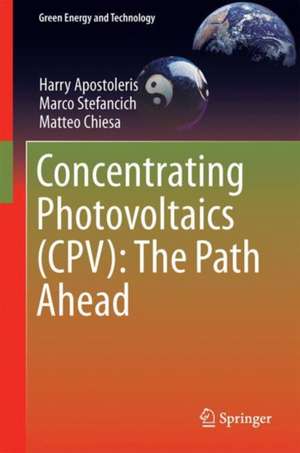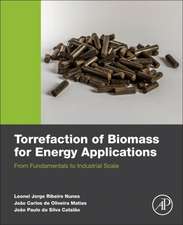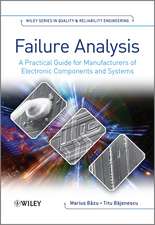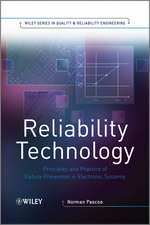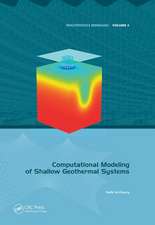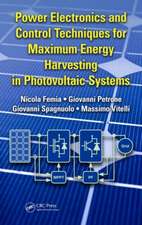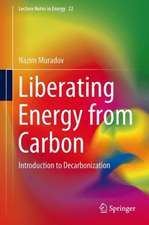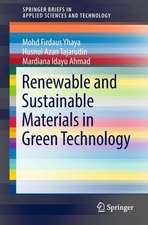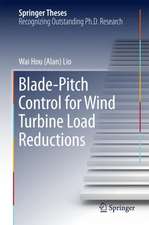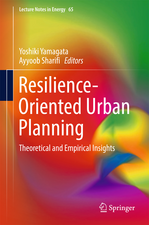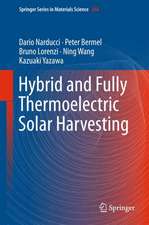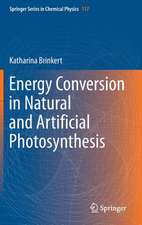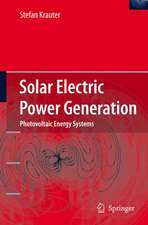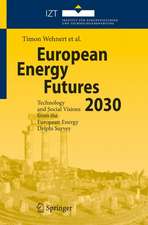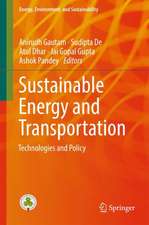Concentrating Photovoltaics (CPV): The Path Ahead: Green Energy and Technology
Autor Harry Apostoleris, Marco Stefancich, Matteo Chiesaen Limba Engleză Hardback – 25 sep 2017
This book is a concise review of the current status and future prospects of concentrating photovoltaic (CPV) technology. Starting with a summary of the current technical and economic status of CPV technology, it identifies the factors that hold CPV back in the commercial market. The main technical areas considered are solar cells, tracking and optics. The solar cells section focuses on spectrum splitting systems, which offer potentially higher efficiency than multi-junction cells with reductions in the manufacturing constraints that lead to high costs. It also offers a brief survey of the latest developments in spectral splitting alongside a discussion of the advances in solar cell manufacturing that aid the development of such systems. Further, it examines electrical design principles for spectral splitting systems that can improve the spectral stability of these systems’ performance. The section on tracking includes a description of tracking integration with an update of the review published in Nature, presenting the latest advances in the field and focusing on surveying conceptual approaches rather than providing an exhaustive description of the literature. The optics section explores 3D printing and other emerging methods of fabricating optics for both prototype and large-scale production, as well as new classes of concentrators, particularly those based on novel photonic materials such as angular filters. Lastly, the authors consider the impact that environmental factors have on the performance of CPV in non-standard environments before concluding with a discussion of the combinations of technologies that they anticipate will most effectively boost CPV in the commercial market.
Din seria Green Energy and Technology
- 18%
 Preț: 943.43 lei
Preț: 943.43 lei - 20%
 Preț: 629.52 lei
Preț: 629.52 lei - 18%
 Preț: 1124.92 lei
Preț: 1124.92 lei - 18%
 Preț: 947.35 lei
Preț: 947.35 lei - 15%
 Preț: 655.92 lei
Preț: 655.92 lei - 18%
 Preț: 957.62 lei
Preț: 957.62 lei - 18%
 Preț: 789.52 lei
Preț: 789.52 lei - 17%
 Preț: 464.56 lei
Preț: 464.56 lei - 15%
 Preț: 645.79 lei
Preț: 645.79 lei - 18%
 Preț: 903.93 lei
Preț: 903.93 lei - 24%
 Preț: 1322.09 lei
Preț: 1322.09 lei - 18%
 Preț: 890.54 lei
Preț: 890.54 lei - 18%
 Preț: 1115.46 lei
Preț: 1115.46 lei - 18%
 Preț: 1117.03 lei
Preț: 1117.03 lei - 18%
 Preț: 949.73 lei
Preț: 949.73 lei - 18%
 Preț: 892.11 lei
Preț: 892.11 lei - 15%
 Preț: 648.24 lei
Preț: 648.24 lei - 18%
 Preț: 997.09 lei
Preț: 997.09 lei - 15%
 Preț: 579.81 lei
Preț: 579.81 lei - 18%
 Preț: 1123.15 lei
Preț: 1123.15 lei - 18%
 Preț: 961.41 lei
Preț: 961.41 lei - 17%
 Preț: 490.23 lei
Preț: 490.23 lei - 18%
 Preț: 904.60 lei
Preț: 904.60 lei - 15%
 Preț: 643.34 lei
Preț: 643.34 lei -
 Preț: 287.91 lei
Preț: 287.91 lei - 24%
 Preț: 634.05 lei
Preț: 634.05 lei -
 Preț: 379.40 lei
Preț: 379.40 lei - 18%
 Preț: 783.20 lei
Preț: 783.20 lei - 18%
 Preț: 956.09 lei
Preț: 956.09 lei - 18%
 Preț: 1394.84 lei
Preț: 1394.84 lei - 18%
 Preț: 1691.57 lei
Preț: 1691.57 lei - 15%
 Preț: 592.61 lei
Preț: 592.61 lei - 18%
 Preț: 952.09 lei
Preț: 952.09 lei - 18%
 Preț: 944.19 lei
Preț: 944.19 lei - 18%
 Preț: 891.33 lei
Preț: 891.33 lei - 18%
 Preț: 1252.44 lei
Preț: 1252.44 lei - 18%
 Preț: 789.52 lei
Preț: 789.52 lei - 20%
 Preț: 566.30 lei
Preț: 566.30 lei - 18%
 Preț: 1112.48 lei
Preț: 1112.48 lei - 18%
 Preț: 1114.24 lei
Preț: 1114.24 lei - 18%
 Preț: 1113.71 lei
Preț: 1113.71 lei - 18%
 Preț: 1011.45 lei
Preț: 1011.45 lei - 24%
 Preț: 590.60 lei
Preț: 590.60 lei - 20%
 Preț: 567.50 lei
Preț: 567.50 lei - 24%
 Preț: 907.50 lei
Preț: 907.50 lei - 18%
 Preț: 952.89 lei
Preț: 952.89 lei
Preț: 692.24 lei
Preț vechi: 814.40 lei
-15% Nou
Puncte Express: 1038
Preț estimativ în valută:
132.48€ • 143.85$ • 111.28£
132.48€ • 143.85$ • 111.28£
Carte tipărită la comandă
Livrare economică 22 aprilie-06 mai
Preluare comenzi: 021 569.72.76
Specificații
ISBN-13: 9783319629797
ISBN-10: 3319629794
Pagini: 68
Ilustrații: VIII, 68 p. 24 illus. in color.
Dimensiuni: 155 x 235 mm
Greutate: 0.29 kg
Ediția:1st ed. 2018
Editura: Springer International Publishing
Colecția Springer
Seria Green Energy and Technology
Locul publicării:Cham, Switzerland
ISBN-10: 3319629794
Pagini: 68
Ilustrații: VIII, 68 p. 24 illus. in color.
Dimensiuni: 155 x 235 mm
Greutate: 0.29 kg
Ediția:1st ed. 2018
Editura: Springer International Publishing
Colecția Springer
Seria Green Energy and Technology
Locul publicării:Cham, Switzerland
Cuprins
Introduction: Why CPV?.- Ch 1: CPV today: economic and technical status.- Ch. 2: Tracking-integrated modules for rooftop-compatible CPV.- Ch. 3: Spectral splitting – the cheap road to ultrahigh efficiency.- Ch. 4: additive manufacturing for low-cost optics.- Ch. 5: CPV in context – environmental conditions and impact on CPV performance.- Ch.6: Conclusions: the path ahead for CPV.
Notă biografică
Harry Apostoleris
Harry Apostoleris is a PhD candidate at the Laboratory for Energy and Nano Science at the Khalifa University of Science and Technology former Masdar Institute, in Abu Dhabi. His research focuses on novel approaches to photovoltaic and solar concentrator systems, including self-tracking solar concentrating systems (SPIE Optical Engineering + Applications, 2015) and spectrum-splitting for photovoltaics (Maragliano et al., Optics Express 2016, Apostoleris et al, SPIE Optical Engineering + Applications, 2017).
Dr. Marco Stefancich
Dr. Marco Stefancich is a senior researcher at DEWA (Dubai Electricity and Water authority) since January 2017. Previously he was a researcher at the National Research Centre, Institute of Materials for Electronics and Magnetism in Parma, Italy. He is a principal investigator in more than 10 projects with Italian, European and UAE private and publi
c entities. In 2006 he co-founded an Italian start-up company for the design, realization and installation of concentrator photovoltaics systems. Marco Stefancich has been a chair at numerous conferences on material research. He has also served as a consultant for private companies on renewable (mostly solar) energy projects (e.g. Solidia srl, “determination of expected performances of a Concentrator Photovoltaic System and design of automatic system for MPPT tracking”). Prof. Matteo Chiesa
Prof. Matteo Chiesa is the head of the LENS (Laboratory for Energy and Nano Science) at the Khalifa University of Science and Technology (former Masdar Institute). His research focuses on the creation and the establishment of technologies necessary to adapt the current energy system into a more sustainable, competitive and secure one, in particular the use of properly designed nanomaterials in low-energy systems. Prof. Chiesa scholarly co
ntribution has focused on understanding, controlling and manipulating matter at the nanoscale where chemical reactions, nucleation processes, corrosion and phase transitions originate. Specifically the effects that atmospheric moisture and the presence of nanoscale water films on surfaces have on such processes have been consistently investigated by means of purposely developed experimental techniques. Prior to joining Masdar Institute faculty in 2007, Prof. Matteo Chiesa was a Post-Doctoral research fellow at the Massachusetts Institute of Technology where he investigated the properties of nanoengineered insulating material that may play a key role in addressing the technological challenges faced by the oil industry in enhancing oil recovery while minimizing its environmental impact. This research was performed in close collaboration with the R&D department at Aibel (former ABB Offshore System) for which he previously served as a technical advisor. He was also employed at SINTEF Petroleum andEnergy, one of the largest European research institutions. He received his PhD in Applied Mechanics in 2001 from the Department of Mechanical Engineering at the Norwegian University of Science and Technology (NTNU), Norway.Textul de pe ultima copertă
This book is a concise review of the current status and future prospects of concentrating photovoltaic (CPV) technology. Starting with a summary of the current technical and economic status of CPV technology, it identifies the factors that hold CPV back in the commercial market. The main technical areas considered are solar cells, tracking and optics. The solar cells section focuses on spectrum splitting systems, which offer potentially higher efficiency than multi-junction cells with reductions in the manufacturing constraints that lead to high costs. It also offers a brief survey of the latest developments in spectral splitting alongside a discussion of the advances in solar cell manufacturing that aid the development of such systems. Further, it examines electrical design principles for spectral splitting systems that can improve the spectral stability of these systems’ performance. The section on tracking includes a description of tracking integration with an update of the review published in Nature, presenting the latest advances in the field and focusing on surveying conceptual approaches rather than providing an exhaustive description of the literature. The optics section explores 3D printing and other emerging methods of fabricating optics for both prototype and large-scale production, as well as new classes of concentrators, particularly those based on novel photonic materials such as angular filters. Lastly, the authors consider the impact that environmental factors have on the performance of CPV in non-standard environments before concluding with a discussion of the combinations of technologies that they anticipate will most effectively boost CPV in the commercial market.
Caracteristici
Argues forcefully for the continued importance of concentrator photovoltaics (CPV) and offers a radical rethinking of the key elements of CPV Focuses on novel, low-cost approaches to optics design and manufacturing Provides a forward-thinking supplement to the traditional approach to CPV Includes supplementary material: sn.pub/extras
